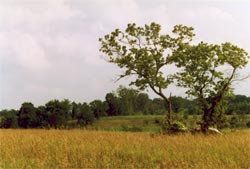 |
||||
      |
||||
(preserving, cont.) But, the lengths the Parsons and many other Wisconsinites have gone to in order to preserve land is more than just a good thing – it is an act of generosity. Stuart Parsons estimates that when he and Phoebe put their land into a conservation easement several years ago, it was worth more than $1 million. And Phoebe Parsons says several prime sites on the property could have attracted developers willing to pay top prices. But Stuart Parsons says giving up the right to develop the land pays off in just knowing that it will be preserved for generations to come. “It’s definitely worth it,” Stuart Parsons says. Phoebe Parsons also feels land conservation is set to become an important part of Wisconsin’s future. “I think this is becoming more popular because I think more people are starting to become aware that it’s a possibility,” Phoebe Parsons says. Dave Horst is among the growing number of Wisconsinites who are learning about land trusts. He got involved with land trusts through his job about a year-and-a-half ago, when he was invited to a breakfast meeting to hear about the non-profit organizations. His interest was immediately piqued. “It seemed to be such a reasonable and effective means of conservancy that it got me interested,” Horst says. “It just made sense.” Horst eventually got involved as a volunteer for a local land trust, and he spent time walking through preserved land to make sure the landowners were complying with the rules of the preservation agreement. Horst thoroughly enjoyed his time touring preserved land, as well as the dedication he saw from the landowners. He and his wife, Jean, plan to eventually set aside 33 acres of former Christmas tree property they purchased. “In the Appleton area here, we’ve seen a lot of development. It seems like every week when you’re driving into work, you see another development going up into what used to be a field. I want assurance that there will be land for people to explore nature and the beauty and tranquility that comes with that,” Horst says. Yet while many landowners are enthusiastic about conserving land, the thousands of dollars in legal fees and appraisal costs prohibit some from working with a land trust to put their land in a preservation agreement. But these landowners can rest assured that when they are ready, there will be a land trust near them willing to help. While Minnesota has only one land trust, Wisconsin’s strong network of 50 organizations holds its own against states with long-standing traditions of land trusts, such as Connecticut, which has one land trust in every township. “Out east there is a tradition of land trusts, and Wisconsin is starting to catch up. I think people are seeing things change and are seeing more development, and they want to do something about it,” says Cate Harrington, director of communications and media for the Nature Conservancy, a state land trust that also serves as an international non-profit organization that deals with other conservation issues. As land trusts work to expand their influence and get the word out to private landowners about what they do, Gauger says only time and the support of landowners who have worked with land trusts can help boost these growing organizations. And he is convinced that the support of satisfied landowners will see to the growth of land trusts. “The individual landowners that we work with are our best advertisers,” Gauger says. “They are the future of land trusts in Wisconsin.”
|
|
||
|
|||
<<previous 1 | 2 | 3 |
|||
|
|||
